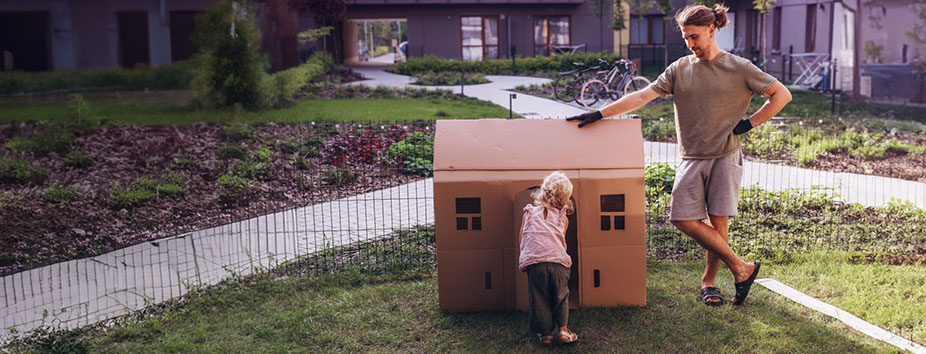What is rentvesting?
Rentvesting is an alternative home owning strategy that’s becoming increasingly common in Australia. It’s especially popular with younger, property buyers, who can’t afford to buy where they want to live.

What you'll learn
- Why rentvest?
- Why rentvesting is popular
- Potential benefits and drawbacks of rentvesting
- Is rentvesting right for you?
Why rentvest?
Owning a home is still a dream for lots of Australians despite the growing challenges that first time home buyers face.
The reality is, many Australians are finding it hard or near impossible, to be able to secure a home close to where they would choose to live or need to work. Which is often close to the beach, an inner-city suburb, or a reasonable commute to a CBD.
Recent figures show that this struggle is real. According to CoreLogic, housing affordability declined in 2023. Saving 20% for a home loan deposit is now estimated to take an average of 9.7 years, especially for a property in the big cities, where nearly 72% of Aussies live.
Rising property prices in sought after areas, recent interest rate hikes, and paying expensive rents while trying to save for a deposit means buyers are looking at creative ways to secure their first home.
Our lenders love to help!
A dedicated lender will be in touch to answer your questions about investment property home loans and guide you through next steps. Your lender will be able to start the application for you.
Enter rentvesting
Rentvesters usually choose to buy in more affordable suburbs and regional or rural areas. Often, they purchase outside the metro centres of our big cities like Melbourne, Sydney or Brisbane. Instead of moving into the home they’ve purchased, they rent it out. Then they rent a place to live that’s in their budget, in a part of the city they like. In this way they get to live in a home in an area that would be out of their budget if they tried to buy it.
Why is it popular?
While it may sound complicated to pay both rent and a mortgage, rentvesting could be a more affordable path to get into the property market.
Firstly, the deposit that you’ll need to save for a less expensive property could be smaller than a more expensive one, depending on your bank’s lending criteria. And secondly, the strategy behind rentvesting is that the investment property you buy acts as an asset that hopefully over time goes up or appreciates in value.
Which means you may be building up equity that you can eventually use to buy another property, including a home you own and live in. In the meantime, your mortgage repayments can be offset by rent paid by your tenants.
While rentvesting could be a good choice for people of all income levels, it works best in areas where the rent you’re paying is much lower than your mortgage repayments would be.
For example, say that buying an apartment in the suburb you currently live in costs you $3550 per month in mortgage repayments. But renting a similar home in the same area would mean paying $1850 each month in rent.
If you rented instead of buying, this would potentially leave you $1700 a month to put towards an investment property deposit in another area, where it may be cheaper to secure a property.
With rising rent prices and a shortage of rental properties in many areas across Australia this can be increasingly difficult to make work. Factor in all your costs, including increasing rental payments and talk to your accountant or tax adviser before deciding to rentvest.
The pros and cons of rentvesting
| Potential benefits of rentvesting | Potential drawbacks of rentvesting |
|---|---|
| Low maintenance costs for the home you’re renting: As a tenant you’re often not responsible for repairs. | Home ownership costs for the property you own: You’ll be responsible for repairs and might need to pay additional fees. |
| Rental income: You may be able to use part of the income from your investment property to cover some of your rent if there’s a surplus. | Less home security: You might have to move if the owner of the property you’re renting wants to sell or change tenants. Also, your rent may go up, but you may not be able to increase the rent your tenants are paying, or move into that property if it’s rented out. |
| Potential tax benefits: You may be able to claim some tax-deductible expenses against the rental income. | Capital Gains Tax: If you sell your investment property you may need to pay tax if there’s any profit. It’s important to factor this in. |
| Potential Capital Gains: If your investment property increases in value, you could make a profit when you sell. | Potential Capital Loss: If your investment property decreases in value, you could lose money when you sell. |
| You can live where you want – you’re not limited to where you can afford to buy. | No First Home Owners Grant: You may lose your eligibility for this grant, which is for first time owner-occupiers. |
| You can more easily change areas or properties when you rent, for example if your lease is up and you would like to try a new suburb or home. | Your mortgage repayments may go up, but you may not be able to increase the rent your tenants are paying due to the tenancy agreement being locked, or because of market conditions. |
Is rentvesting right for you?
Like all investments there’s risks involved in rentvesting. Your asset’s property value may go down as well as up. And the rent you get may not always cover the mortgage repayments, so you need to have enough cash flow to cover both your rent and the loan repayments if needed.
You can read our article on investment property depreciation to find out more.
Plus, there will be upfront costs when buying an investment property including stamp duty, legal costs, council rates, strata fees and ongoing maintenance fees. All of these should be factored in as part of your investment property strategy.
There’s also tax implications to becoming an investor. It’s important to speak to a tax adviser or accountant before you start to see if it’s the right financial decision for you.
Rentvesting can let you play the property game in a way that suits your needs and circumstances. It can mean you keep a city lifestyle while building wealth by investing in properties out of your area. So if you’ve done the discovery, explored all the pros and cons and are ready to rentvest, check out our range of investment home loan options.
Keep exploring
Things you should know
Conditions, credit criteria, fees and charges apply. Residential lending is not available for Non-Australian Resident borrowers.
This information is general in nature and has been prepared without taking your personal objectives, circumstances and needs into account. You should consider the appropriateness of the information to your own circumstances and, if necessary, seek appropriate professional advice.
Any tax information described is general in nature and it is not tax advice or a guide to tax laws. We recommend you seek independent, professional tax advice applicable to your personal circumstances.
Taxation considerations in this publication should not be interpreted or used as tax advice or a tax guide.


